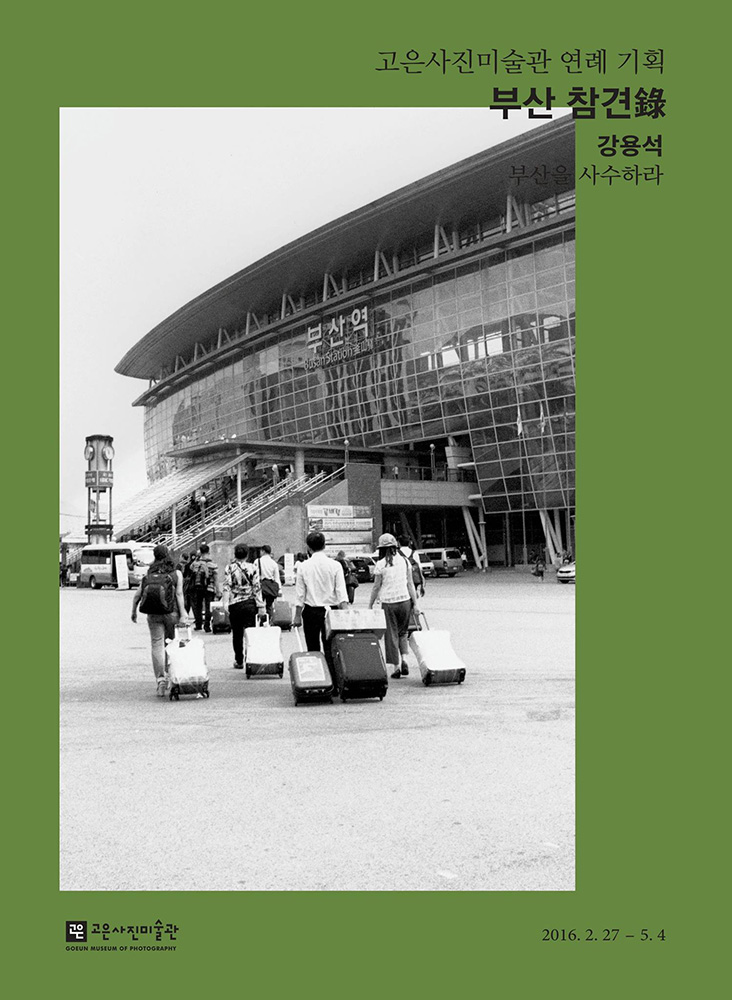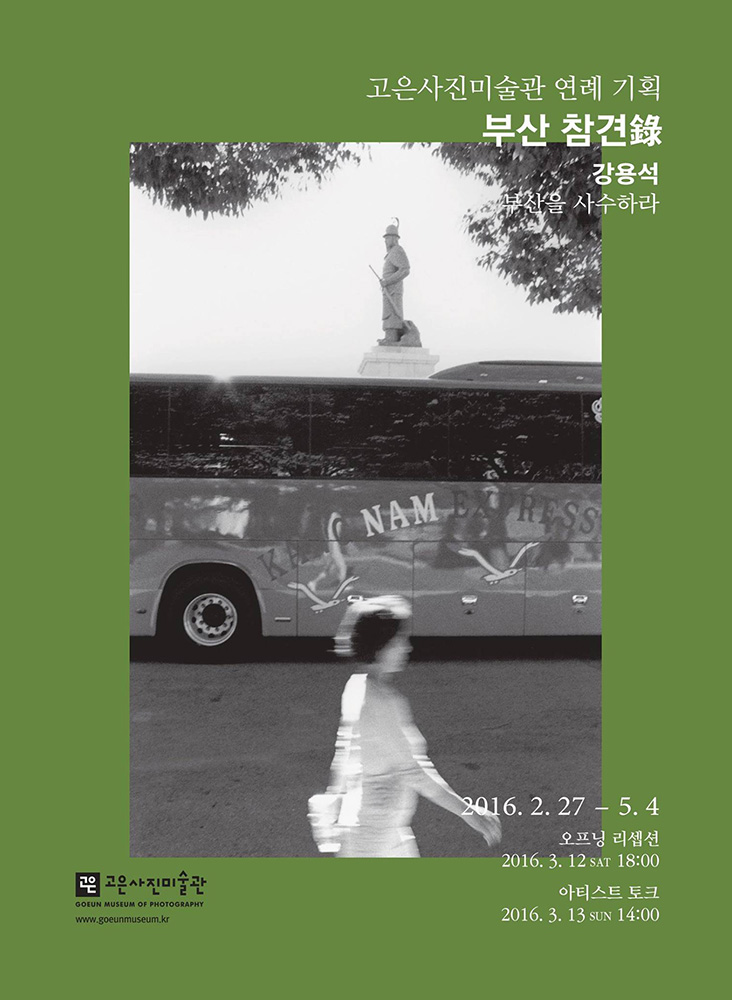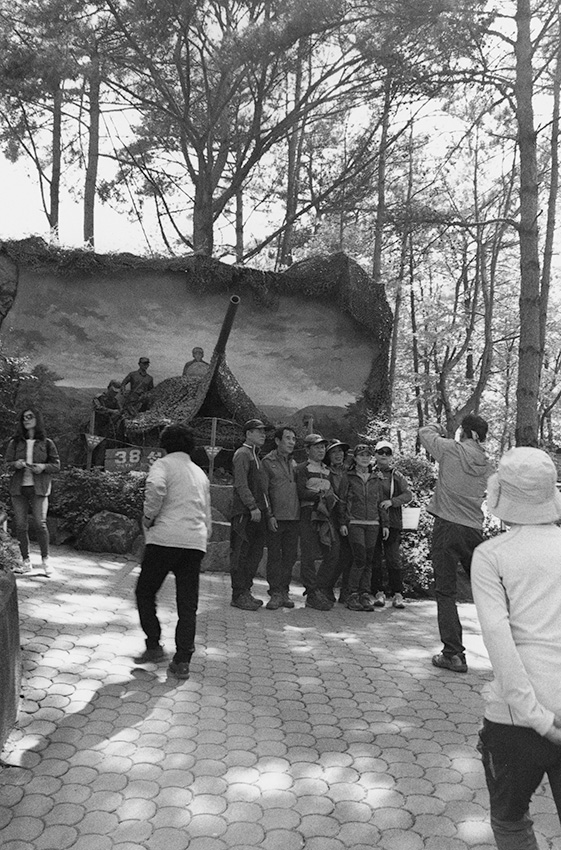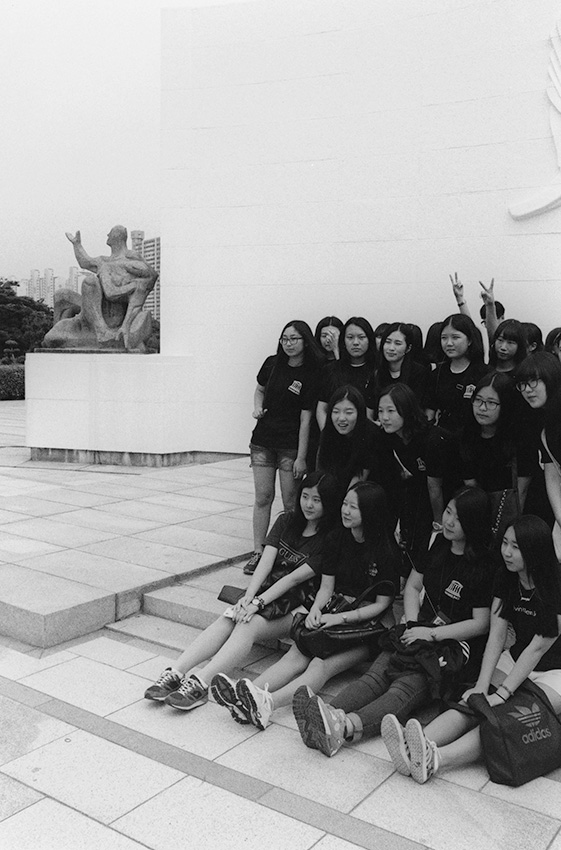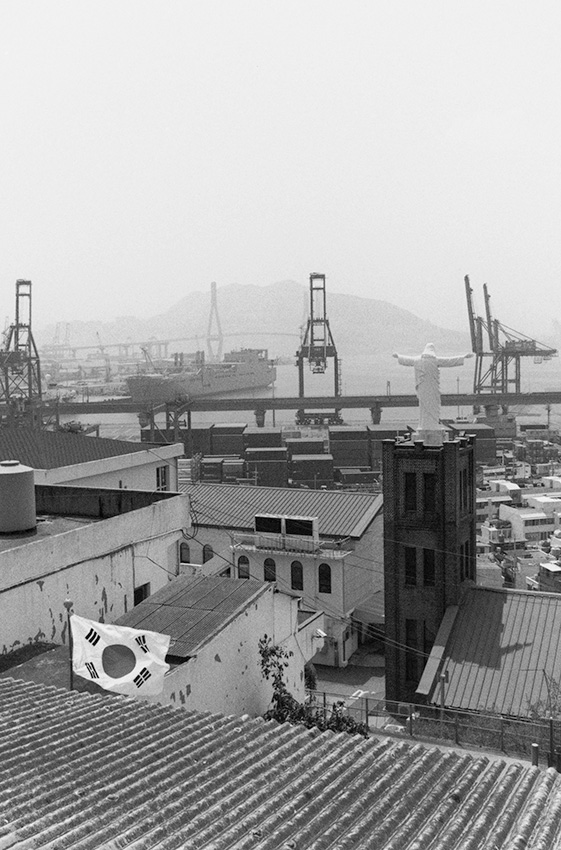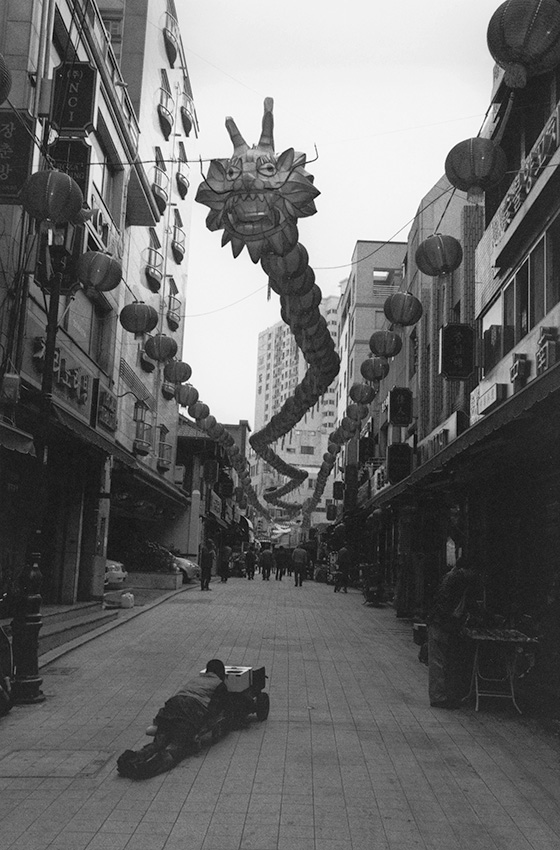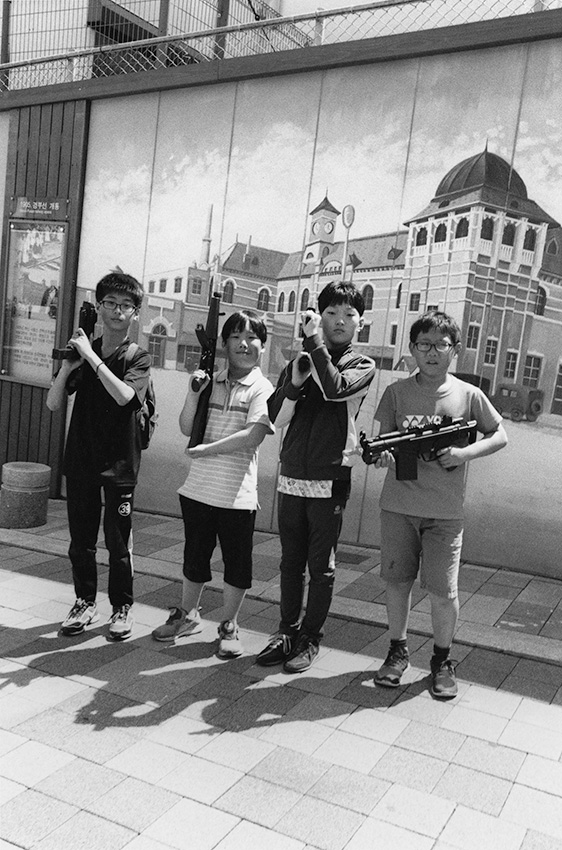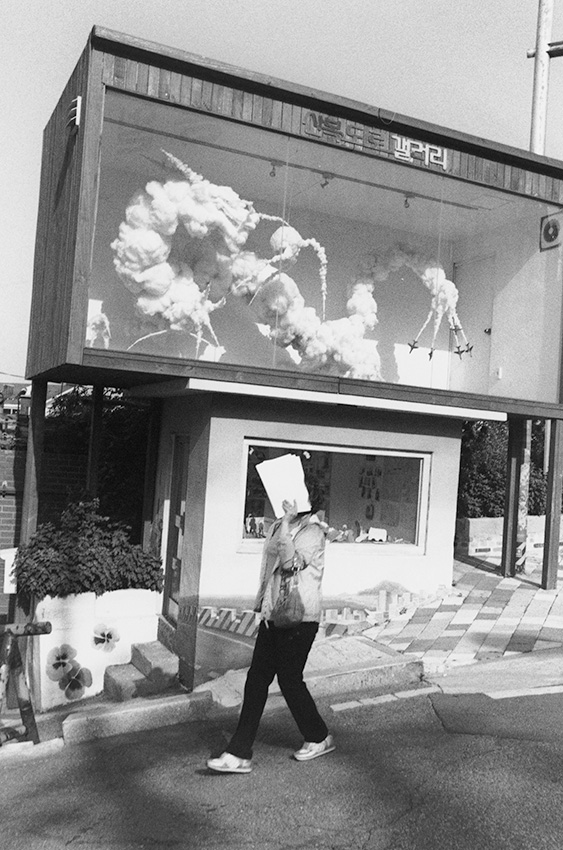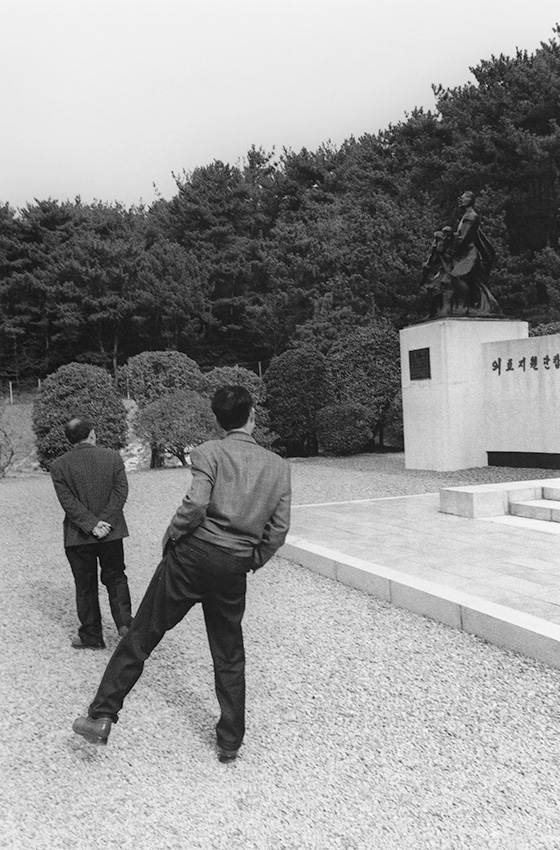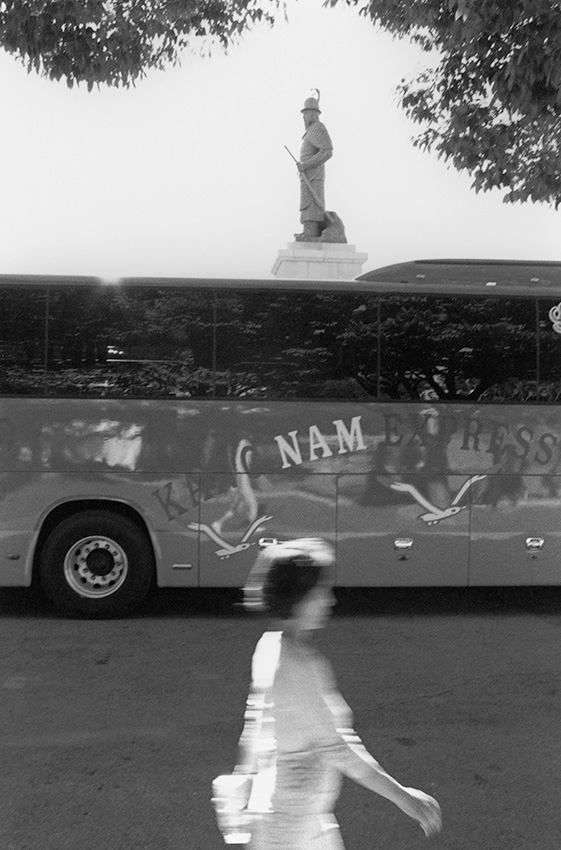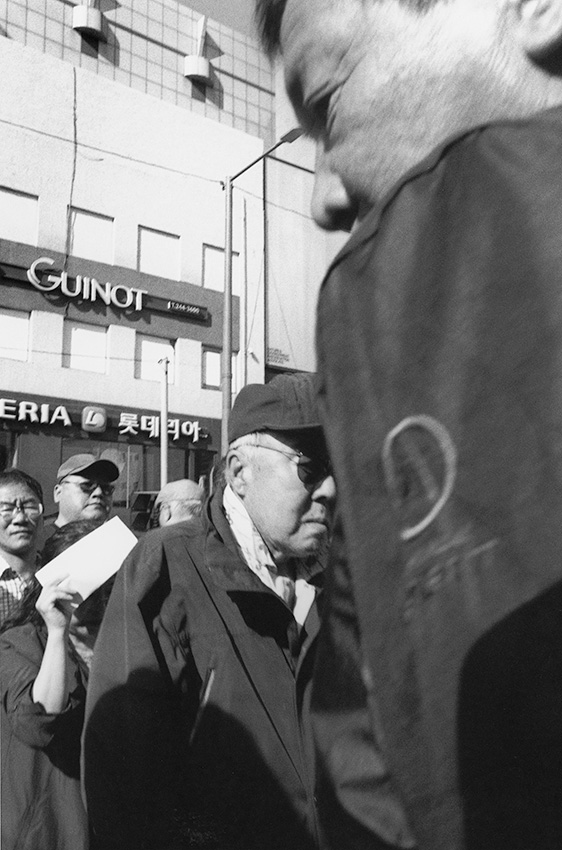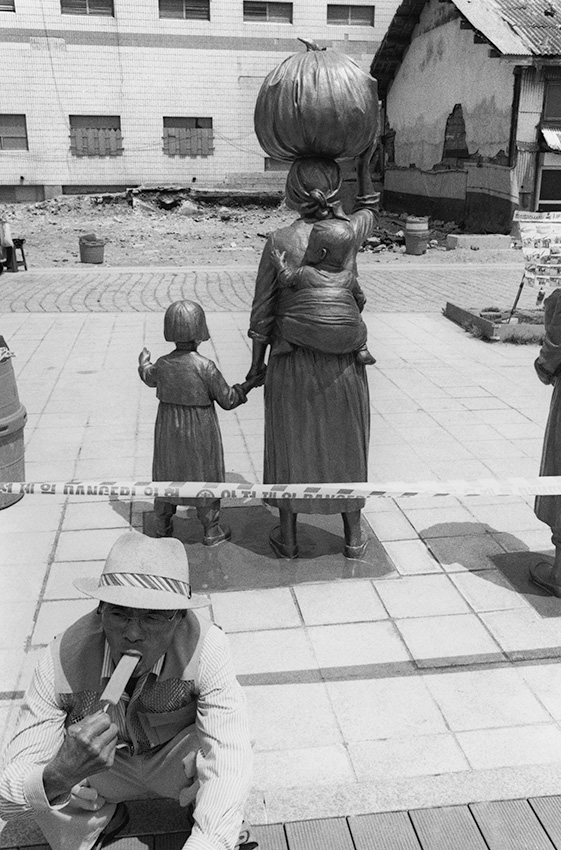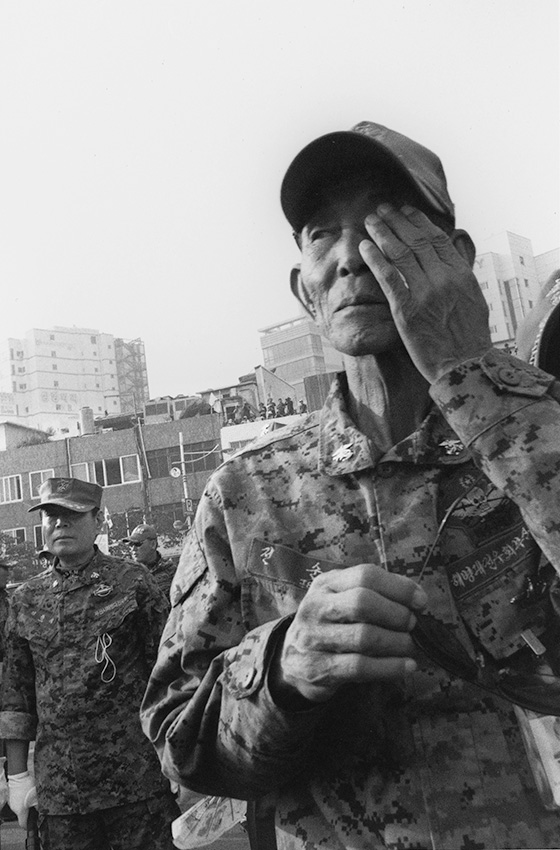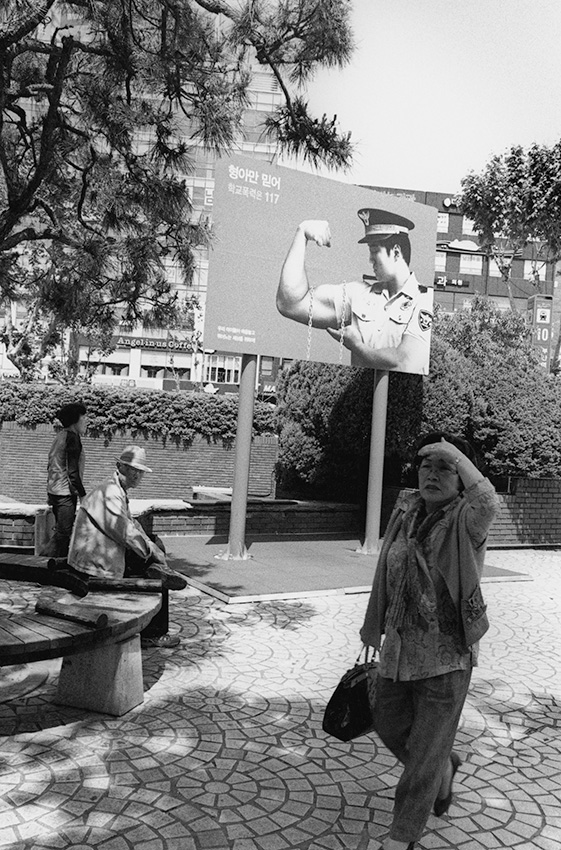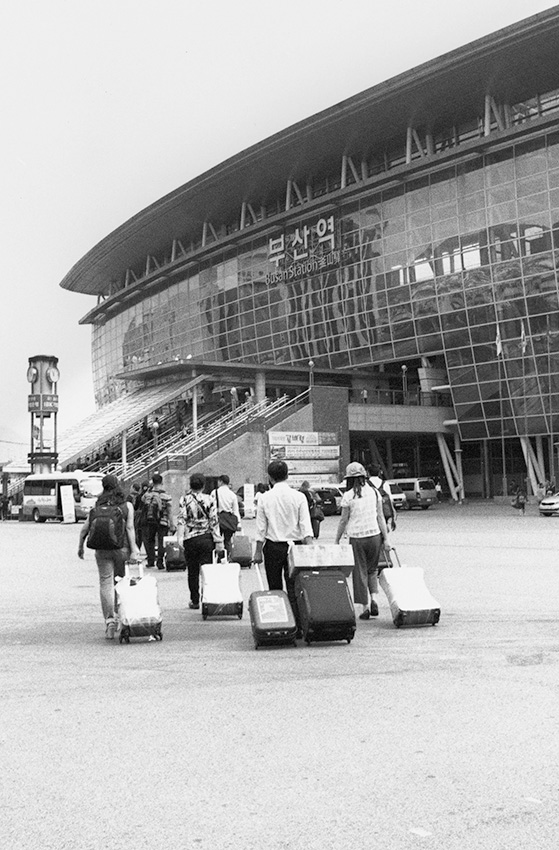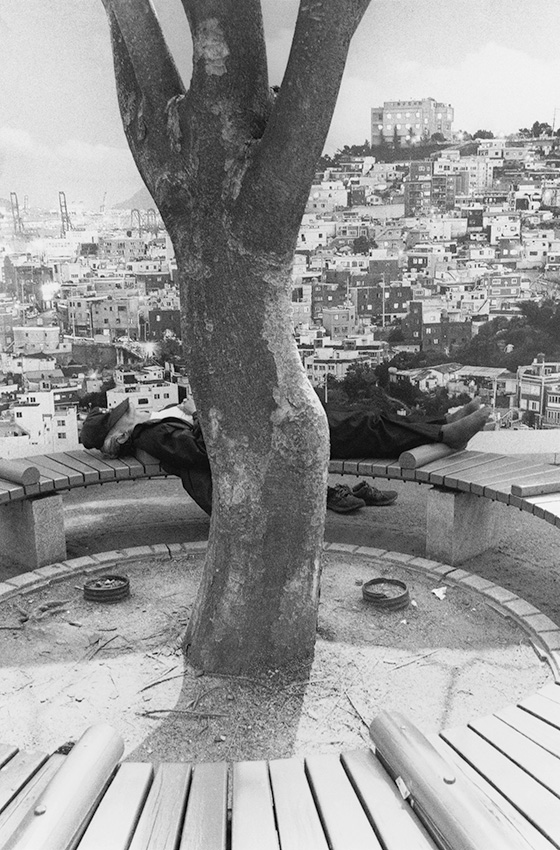GoEun Museum of Photography's Annual Project [Busan Observation] has chosen YongSuk Kang for its 2016 exhibition, an artist who has contemplated the issues of Korean society arisen after the Korean War. [Busan Observation]is a decade long project, assigning an experienced and talented photographer every year to document the history and local colors of Busan in his or her own unique views which are exhibited at the Museum once completed. Previous participants HongGoo Kang (2013), KwangHo Choi (2014), GapChul Lee (2015) are followed by the fourth artist YongSuk Kang this year, who have captured the traces of Korean War after 65 years of its breakout, at Busan, in 2016.
고은사진미술관 연례 기획 [부산 참견錄] 2016의 작가는 한국전쟁 이후에 파생된 한국사회의 문제에 천착 해온 사진가 강용석이다. [부산 참견錄]은 매년 한국의 중견사진가들 중 한 명을 선정하여 부산의 역사성 과 지역성을 자신만의 독창적인 시각으로 기록하도록 지원하고, 그 결과물을 전시로 선보이는 10년 장기 프로젝트이다. 2013년 강홍구와 2014년 최광호 그리고 2015년 이갑철에 이어 네 번째로 선정된 강용석 은 한국전쟁이 발발한 지 65년이 지난 2015년의 부산에서 그 흔적을 포착한다.
한국전쟁 참전 장교의 경험을 기록한 책 이름에서 《부산을 사수하라》라는 전시제목을 빌려온 작가는 시간을 거슬러 한국전쟁 이후 부산을 포함한 낙동강 이남의 사람들은 물론 그들의 삶 주변에 여전히 잔존하는 전쟁 의 긴장과 안도의 감정 그 혼돈의 흔적들을 추적한다. 시간의 흐름과 함께 퇴색되거나 왜곡되어 가는 한국 전쟁의 경험과 기억을 현재의 시점에서 돌아보고 있는 그의 작업은 긴장과 이완, 불안과 안도, 숨겨진 공 포와 무감각이라는 이중적 감정을 세로형 포맷과 사선의 구도 그리고 특유의 차분한 흑백 중간톤의 형식으로 드러낸다. 이 작업은 [동두천 기념사진](1984)과 [매향리 풍경](1999), 그리고 [한국전쟁기념비 ](2006-2009)에 이은 강용석의 한국전쟁 프로젝트의 또 다른 버전이기도 하며, 그가 일관되게 보여주었 던 한국전쟁 이후에 생겨난 사회문제와 의식의 변화에 대한 관심의 연장선상에 있다.
이번 전시는 부산이라는 장소 곳곳에 한국전쟁과 분단이라는 상황이 만들어내고 있는 다양한 풍경을 포착하 고 있는 강용석의 시선을 따라간다. 민족의 상흔이 바꾸어 놓은 부산 사람들의 삶, 특정한 장소에서 불쑥 불쑥 튀어나오는 전쟁의 기억, 그러한 기억의 집단적인 소비와 강박적인 기념, 그리고 그것들과 평범한 일 상이 충돌하면서 만들어내는 이야기들은 강용석이 부산이라는 도시를 어떻게 작업 속에 투영하고 있는지를 여실히 보여준다. 전쟁이 끝난 것이 아니라 여전히 진행 중이라는 사실을 감정에 호소하지 않고 냉정한 시 선으로 포착하고 있는 것이다. 그래서 그의 사진은 얼핏 보면 단조롭고 평이하지만, 가까이 다가가 보면 매우 흥미로운 구성을 취하고 있다. 여러 요소들이 나름의 질서를 가지고 조화로운 구조를 만들고 있기 때 문이다. 그는 프레임 속 대상들의 관계를 절묘하게 이용하면서 그 속에서 미묘하게 충돌하는 의미들을 드러 내는 방식을 취한다.
모두가 지워버리고 싶어하는 우리의 역사를 기념사진의 형태로 담아낸 [동두천 기념사진]과 끝나지 않은 전 쟁의 공기감을 절묘하게 포착한 [매향리 풍경] 그리고 기념의 의미를 다시금 반추하는 [한국전쟁기념비]에 서 알 수 있듯이, 그는 바뀌는 소재와 주제에 따라 기법과 형식에도 변화를 주었다. [부산을 사수하라]는 부산의 특정한 장소와 사람들을 면밀히 관찰하여 아직 끝나지 않은, 시간이 흐르면서 굴절되고 변형된 흔적 들을 스냅사진으로 기록한다. 산복도로와 중앙동 그리고 부산역 등 원도심의 공간에서 얼굴을 가리거나 고개 를 숙이고, 등지고 있는 사람들의 모습에서 위태로운 긴장감이 감돈다. 이제는 흔한 풍경이 되어버린 노숙 자의 모습, 기념탑과 동상, 기념공원 안에서 보이는 다양한 제스처, 전쟁이 하나의 소비문화로 자리잡은 순간들, 그리고 사람들의 표정과 그림자 속에서 암시적으로 드러나는 불안과 긴장 이 모든 것들이 한국전쟁 과 관계된 하나의 주제로 수렴된다. 그가 순간적인 움직임과 현상의 변화를 재빠르게 포착할 수 있는 35mm 카메라를 선택한 이유가 바로 여기에 있다. 그는 어떻게 하면 대상을 가장 효과적으로 드러낼지, 그 것에 포함된 의미와 내용을 어떠한 방식으로 시각화할지를 명료하게 인식하고 있다. 옆에 있는 간판 속의 인물 혹은 동상과 비슷하게 포즈를 취한 사람들, 기둥과 나무 등으로 분할되는 공간, 벽화나 현수막 앞에 서 자리잡은 인물 등 프레임 속의 대상들은 서로 관계를 맺으며 다양한 이야기를 만들어낸다. 이로써, 면 밀히 들여다보면서 그 속의 이야기를 읽어내고 상상하며 의미를 확장하는 것은 온전히 관객의 몫으로 남겨진다.
한국전쟁이, 그리고 부산이라는 장소가 어떻게 보편성을 획득하고 일반적인 공감을 얻어낼 수 있을까? 다양 한 내용을 하나로 묶는 힘은 작업의 형식에서 나온다. 강용석의 사진은 강렬함으로 눈길을 끌기보다는 그 안에 표현된 톤과 구성의 절묘한 조화로 시선을 사로잡는다. 감정을 최대한 배제하고 보편성을 획득하기 위 해 그가 줄곧 선택해오고 있는 회색의 중간톤은 그의 말처럼 일종의 사진적 “문법”으로 작동한다. 여기에 선택된 또 하나의 형식인 세로형 포맷은 그 덤덤함 속에 숨어 있는 불안과 공포 그리고 긴장감을 끄집어내 며 시선을 집중시킨다. 여기에 사소한 대상들을 유사한 형태나 반복되는 상황으로 묶어내면서 완벽한 구성이 비로소 만들어진다. 무미건조하면서 흥미롭기도 하고, 짠하면서 우스꽝스럽기도 하고, 왠지 모르게 불안하면 서도 무덤덤한, 이렇게 복잡한 감정들의 미묘한 뉘앙스는 관객들을 유혹하는 동시에 질문하고 지각하게 만든다. 전쟁의 흔적과 기억 그리고 그 뒤에 남은 감정을 되새기는 작업은 이렇게나 어려운 일이다. 삶은 계속 되고 전쟁은 여전히 진행 중이며, 강용석의 작업 역시 그러할 것이다.
부산은 한국의 격동기를 온몸으로 겪어낸 도시이다. 그리고 가장 먼저 사진을 받아들인 곳이자 세계로 열려 있는 관문으로서 다양한 문화가 어우러진 다채롭고 활기찬 도시이다. 고은사진미술관의 연례 기획 [부산 참견錄]을 통해 한국 중견사진가들이 찾아낸 다양한 부산의 모습은 단순한 기록을 넘어 한국 사진계의 성과로 남을 것이며, 또한 부산 지역의 역사적 문화적 스펙트럼을 확장하는 데 기여하게 될 것이다.
고은사진미술관
한국전쟁 참전 장교의 경험을 기록한 책 이름에서 《부산을 사수하라》라는 전시제목을 빌려온 작가는 시간을 거슬러 한국전쟁 이후 부산을 포함한 낙동강 이남의 사람들은 물론 그들의 삶 주변에 여전히 잔존하는 전쟁 의 긴장과 안도의 감정 그 혼돈의 흔적들을 추적한다. 시간의 흐름과 함께 퇴색되거나 왜곡되어 가는 한국 전쟁의 경험과 기억을 현재의 시점에서 돌아보고 있는 그의 작업은 긴장과 이완, 불안과 안도, 숨겨진 공 포와 무감각이라는 이중적 감정을 세로형 포맷과 사선의 구도 그리고 특유의 차분한 흑백 중간톤의 형식으로 드러낸다. 이 작업은 [동두천 기념사진](1984)과 [매향리 풍경](1999), 그리고 [한국전쟁기념비 ](2006-2009)에 이은 강용석의 한국전쟁 프로젝트의 또 다른 버전이기도 하며, 그가 일관되게 보여주었 던 한국전쟁 이후에 생겨난 사회문제와 의식의 변화에 대한 관심의 연장선상에 있다.
이번 전시는 부산이라는 장소 곳곳에 한국전쟁과 분단이라는 상황이 만들어내고 있는 다양한 풍경을 포착하 고 있는 강용석의 시선을 따라간다. 민족의 상흔이 바꾸어 놓은 부산 사람들의 삶, 특정한 장소에서 불쑥 불쑥 튀어나오는 전쟁의 기억, 그러한 기억의 집단적인 소비와 강박적인 기념, 그리고 그것들과 평범한 일 상이 충돌하면서 만들어내는 이야기들은 강용석이 부산이라는 도시를 어떻게 작업 속에 투영하고 있는지를 여실히 보여준다. 전쟁이 끝난 것이 아니라 여전히 진행 중이라는 사실을 감정에 호소하지 않고 냉정한 시 선으로 포착하고 있는 것이다. 그래서 그의 사진은 얼핏 보면 단조롭고 평이하지만, 가까이 다가가 보면 매우 흥미로운 구성을 취하고 있다. 여러 요소들이 나름의 질서를 가지고 조화로운 구조를 만들고 있기 때 문이다. 그는 프레임 속 대상들의 관계를 절묘하게 이용하면서 그 속에서 미묘하게 충돌하는 의미들을 드러 내는 방식을 취한다.
모두가 지워버리고 싶어하는 우리의 역사를 기념사진의 형태로 담아낸 [동두천 기념사진]과 끝나지 않은 전 쟁의 공기감을 절묘하게 포착한 [매향리 풍경] 그리고 기념의 의미를 다시금 반추하는 [한국전쟁기념비]에 서 알 수 있듯이, 그는 바뀌는 소재와 주제에 따라 기법과 형식에도 변화를 주었다. [부산을 사수하라]는 부산의 특정한 장소와 사람들을 면밀히 관찰하여 아직 끝나지 않은, 시간이 흐르면서 굴절되고 변형된 흔적 들을 스냅사진으로 기록한다. 산복도로와 중앙동 그리고 부산역 등 원도심의 공간에서 얼굴을 가리거나 고개 를 숙이고, 등지고 있는 사람들의 모습에서 위태로운 긴장감이 감돈다. 이제는 흔한 풍경이 되어버린 노숙 자의 모습, 기념탑과 동상, 기념공원 안에서 보이는 다양한 제스처, 전쟁이 하나의 소비문화로 자리잡은 순간들, 그리고 사람들의 표정과 그림자 속에서 암시적으로 드러나는 불안과 긴장 이 모든 것들이 한국전쟁 과 관계된 하나의 주제로 수렴된다. 그가 순간적인 움직임과 현상의 변화를 재빠르게 포착할 수 있는 35mm 카메라를 선택한 이유가 바로 여기에 있다. 그는 어떻게 하면 대상을 가장 효과적으로 드러낼지, 그 것에 포함된 의미와 내용을 어떠한 방식으로 시각화할지를 명료하게 인식하고 있다. 옆에 있는 간판 속의 인물 혹은 동상과 비슷하게 포즈를 취한 사람들, 기둥과 나무 등으로 분할되는 공간, 벽화나 현수막 앞에 서 자리잡은 인물 등 프레임 속의 대상들은 서로 관계를 맺으며 다양한 이야기를 만들어낸다. 이로써, 면 밀히 들여다보면서 그 속의 이야기를 읽어내고 상상하며 의미를 확장하는 것은 온전히 관객의 몫으로 남겨진다.
한국전쟁이, 그리고 부산이라는 장소가 어떻게 보편성을 획득하고 일반적인 공감을 얻어낼 수 있을까? 다양 한 내용을 하나로 묶는 힘은 작업의 형식에서 나온다. 강용석의 사진은 강렬함으로 눈길을 끌기보다는 그 안에 표현된 톤과 구성의 절묘한 조화로 시선을 사로잡는다. 감정을 최대한 배제하고 보편성을 획득하기 위 해 그가 줄곧 선택해오고 있는 회색의 중간톤은 그의 말처럼 일종의 사진적 “문법”으로 작동한다. 여기에 선택된 또 하나의 형식인 세로형 포맷은 그 덤덤함 속에 숨어 있는 불안과 공포 그리고 긴장감을 끄집어내 며 시선을 집중시킨다. 여기에 사소한 대상들을 유사한 형태나 반복되는 상황으로 묶어내면서 완벽한 구성이 비로소 만들어진다. 무미건조하면서 흥미롭기도 하고, 짠하면서 우스꽝스럽기도 하고, 왠지 모르게 불안하면 서도 무덤덤한, 이렇게 복잡한 감정들의 미묘한 뉘앙스는 관객들을 유혹하는 동시에 질문하고 지각하게 만든다. 전쟁의 흔적과 기억 그리고 그 뒤에 남은 감정을 되새기는 작업은 이렇게나 어려운 일이다. 삶은 계속 되고 전쟁은 여전히 진행 중이며, 강용석의 작업 역시 그러할 것이다.
부산은 한국의 격동기를 온몸으로 겪어낸 도시이다. 그리고 가장 먼저 사진을 받아들인 곳이자 세계로 열려 있는 관문으로서 다양한 문화가 어우러진 다채롭고 활기찬 도시이다. 고은사진미술관의 연례 기획 [부산 참견錄]을 통해 한국 중견사진가들이 찾아낸 다양한 부산의 모습은 단순한 기록을 넘어 한국 사진계의 성과로 남을 것이며, 또한 부산 지역의 역사적 문화적 스펙트럼을 확장하는 데 기여하게 될 것이다.
고은사진미술관
GoEun Museum of Photography's Annual Project [Busan Observation] has chosen YongSuk Kang for its 2016 exhibition, an artist who has contemplated the issues of Korean society arisen after the Korean War. [Busan Observation]is a decade long project, assigning an experienced and talented photographer every year to document the history and local colors of Busan in his or her own unique views which are exhibited at the Museum once completed. Previous participants HongGoo Kang (2013), KwangHo Choi (2014), GapChul Lee (2015) are followed by the fourth artist YongSuk Kang this year, who have captured the traces of Korean War after 65 years of its breakout, at Busan, in 2016.
The exhibition title Protecting Busan comes from a book documenting the memories of a Korean War veteran officer. It goes back in time and follows the tension of War, the sentiments of relief and the traces of turmoil still existing in the lives and their surroundings of people living south of Nakdong River, including the Busan area. From a current perspective his work looks back at the experiences and memories of Korean War that are fading or being distorted in the course of time. It exposes the contradicting emotions of tension and relaxation as well as the hidden fear and insensibility through the vertical format, diagonal composition and his signatory monochromic tones that have a calming effect. The project is a variation of Kang's former Korean War projects, Dongducheon Commemorative Photographs (1999) and The Korean War Monuments (2006-2009) that continues to express his deep interest in the post-War social issues and change of ideology.
The exhibition follows what YongSuk Kang has seen, capturing various sceneries happening in various places of Busan that are induced by the Korean War and the divided condition of the Peninsula. The lives of Busan people altered by the scars left across the country, the memories of War suddenly protruding from certain places, the collective consumption of such memories and compulsive celebrations, and the stories created as these elements collide with everyday life―they genuinely reveal how YongSuk Kang projects the city of Busan in his work. Instead of making an emotional plea, his unemotional eyes capture the fact that the War is not over but is still continuing. Therefore his photographs may seem simple and general at first, but look closer and you will find some very interesting forms. Several elements with their own order come together to create a harmonious composition. He uses delicately the relationships of the subjects in the frame and chooses to subtly reveal the significances that are colliding within.
Dongducheon Commemorative Photographs shows the history everyone wishes to erase in the form of souvenir photographs while From the Maehyang-ri exquisitely seizes the atmosphere of the War that is yet to end, and The Korean War Monuments reflects on the significance of commemoration. As evident in these projects, the artist has altered his techniques and formats according to the changing subjects and themes. Protecting Busan meticulously observes the specific locations and people of Busan, to document in the form of snap shots the traces that are still current, that are distorted and changed in the course of time. People hiding their faces, their heads turned down or their backs turned against the camera at places like the hillside houses, Jungang-dong, Busan Station and original downtown areas, express some critical tension in them. The looks of homeless people, monuments, statues, different gestures made in memorial parks, moments where the War is transformed and settled as a consumer culture, and the suggestive anxiety and tension that are shown in the people’s expressions and shadows. All of them are condensed into a single theme connected to the Korean War. That is why he has chosen a 35mm camera, as to capture those instantaneous movements and changes of phenomenon. He has a clear perception on what needs to be done to most effectively expose the subject and how to visualize its significance and meanings. People mimicking the postures of those in the signage boards or statues, the space divided by a pillar or a tree, men standing next to a mural or banner are subjects in the frame that establish relationships with each other to create a variety of stories. Thus the work of making a close observation to decipher their stories, to deduce and expand their meanings is solely left to the viewers.
How can the Korean War and the location of Busan obtain universality and gain general sympathy? The power that consolidates different contents into one comes from the work’s format. Instead of drawing attention with intensity, Kang’s photographs attract the viewers with the exquisite harmony of their tones and compositions that are expressed within. The grey, neutral tone Kang has insisted on using to exclude as much emotion as possible and gain universality operates as a photographic ‘grammar’ as he has said himself. In addition, the vertical format exposes the anxiety, fear and tension that hide in the placidity and make viewers focus. As trivial subjects are bound together in similar formats or repeating situations, a perfect composition is finally completed. The subtle nuance of the complicated emotions - dry yet interesting, heartwarming yet ridiculous, somehow nervous yet indifferent - lures the viewers and at the same time makes them ask questions and become aware. Reliving the traces and memories of war, and the emotions left behind is a difficult task in such ways. Life goes on while the War continues, as will YongSuk Kang’s projects.
Busan is a city that has faced the dynamic era of Korea squarely. It is also the first place to adopt photography and is a gateway open to the world where diverse cultures mingle with energy. Through GoEun Museum of Photography’s Annual Project [Busan Observation], multiple faces of Busan will be discovered by skilled Korean photographers which will be more than simple documentation. They will become the jewels of Korean photography while contributing to expansion of historical and cultural spectrums in the Busan.
GoEun Museum of Photography
The exhibition title Protecting Busan comes from a book documenting the memories of a Korean War veteran officer. It goes back in time and follows the tension of War, the sentiments of relief and the traces of turmoil still existing in the lives and their surroundings of people living south of Nakdong River, including the Busan area. From a current perspective his work looks back at the experiences and memories of Korean War that are fading or being distorted in the course of time. It exposes the contradicting emotions of tension and relaxation as well as the hidden fear and insensibility through the vertical format, diagonal composition and his signatory monochromic tones that have a calming effect. The project is a variation of Kang's former Korean War projects, Dongducheon Commemorative Photographs (1999) and The Korean War Monuments (2006-2009) that continues to express his deep interest in the post-War social issues and change of ideology.
The exhibition follows what YongSuk Kang has seen, capturing various sceneries happening in various places of Busan that are induced by the Korean War and the divided condition of the Peninsula. The lives of Busan people altered by the scars left across the country, the memories of War suddenly protruding from certain places, the collective consumption of such memories and compulsive celebrations, and the stories created as these elements collide with everyday life―they genuinely reveal how YongSuk Kang projects the city of Busan in his work. Instead of making an emotional plea, his unemotional eyes capture the fact that the War is not over but is still continuing. Therefore his photographs may seem simple and general at first, but look closer and you will find some very interesting forms. Several elements with their own order come together to create a harmonious composition. He uses delicately the relationships of the subjects in the frame and chooses to subtly reveal the significances that are colliding within.
Dongducheon Commemorative Photographs shows the history everyone wishes to erase in the form of souvenir photographs while From the Maehyang-ri exquisitely seizes the atmosphere of the War that is yet to end, and The Korean War Monuments reflects on the significance of commemoration. As evident in these projects, the artist has altered his techniques and formats according to the changing subjects and themes. Protecting Busan meticulously observes the specific locations and people of Busan, to document in the form of snap shots the traces that are still current, that are distorted and changed in the course of time. People hiding their faces, their heads turned down or their backs turned against the camera at places like the hillside houses, Jungang-dong, Busan Station and original downtown areas, express some critical tension in them. The looks of homeless people, monuments, statues, different gestures made in memorial parks, moments where the War is transformed and settled as a consumer culture, and the suggestive anxiety and tension that are shown in the people’s expressions and shadows. All of them are condensed into a single theme connected to the Korean War. That is why he has chosen a 35mm camera, as to capture those instantaneous movements and changes of phenomenon. He has a clear perception on what needs to be done to most effectively expose the subject and how to visualize its significance and meanings. People mimicking the postures of those in the signage boards or statues, the space divided by a pillar or a tree, men standing next to a mural or banner are subjects in the frame that establish relationships with each other to create a variety of stories. Thus the work of making a close observation to decipher their stories, to deduce and expand their meanings is solely left to the viewers.
How can the Korean War and the location of Busan obtain universality and gain general sympathy? The power that consolidates different contents into one comes from the work’s format. Instead of drawing attention with intensity, Kang’s photographs attract the viewers with the exquisite harmony of their tones and compositions that are expressed within. The grey, neutral tone Kang has insisted on using to exclude as much emotion as possible and gain universality operates as a photographic ‘grammar’ as he has said himself. In addition, the vertical format exposes the anxiety, fear and tension that hide in the placidity and make viewers focus. As trivial subjects are bound together in similar formats or repeating situations, a perfect composition is finally completed. The subtle nuance of the complicated emotions - dry yet interesting, heartwarming yet ridiculous, somehow nervous yet indifferent - lures the viewers and at the same time makes them ask questions and become aware. Reliving the traces and memories of war, and the emotions left behind is a difficult task in such ways. Life goes on while the War continues, as will YongSuk Kang’s projects.
Busan is a city that has faced the dynamic era of Korea squarely. It is also the first place to adopt photography and is a gateway open to the world where diverse cultures mingle with energy. Through GoEun Museum of Photography’s Annual Project [Busan Observation], multiple faces of Busan will be discovered by skilled Korean photographers which will be more than simple documentation. They will become the jewels of Korean photography while contributing to expansion of historical and cultural spectrums in the Busan.
GoEun Museum of Photography
부산을 사수하라
강용석
그곳은 바로 부산! [중략] 해안은 가파르고 울퉁불퉁했으며 나무 한 그루 없이 발가벗겨져 있었고 군데군데 풀포기와 빨간 흙, 갈색 돌덩이만이 존재를 자랑하고 있었다. [중략] 마치 부산이라는 곳이 해변 언덕 위에서 미끄러져 내려와 바닷가에 저절로 생겨난 혼돈 덩어리로 된 곳인 것 같았다. 색깔이란 없었다. 내가 지금 그때의 부산을 생각하면 회색빛만 떠오른다.1
지금 왜 우리가 전쟁을 하고 있어야 하는지를 고민하는 사람은 아무도 없다. [중략] 이 순간에도 그 놈들을 죽이는 것, 천 명을 죽이는 것, 열 받은 총알로, 차가운 총검으로, 폭발물을 터뜨려 죽이는 것, 그냥 죽이는 것. 우리는 이미 살인자가 되어 있었다.2
1950년 6월 25일에 발발한 한반도에서의 한국전쟁은 세계사적으로나 민족사적으로 매우 중요한 의미를 갖는다. 이 전쟁은 남북한 군인들과 민간인들뿐만 아니라 미국을 위시한 여러 나라 군인들이 참전한 국제적 내전이었다. 또한 이 전쟁으로 인하여 수백만 명의 내외국인 사상자가 발생했으며, 전 국토는 황폐화되어 회복하는 데에도 수십 년의 세월을 필요로 했다.
이러한 한국전쟁 원인으로는 “소련의 스탈린이 당시 새롭게 재편되는 아시아의 전략적 상황과 북한 지도부의 무력통일론을 이용하여 미국과의 냉전대결에서 결정적인 승기를 잡기 위하여 한국을 미국의 세력권으로부터 제거하려는 롤백 전략(rollback strategy)을 추구하는 과정에서 한국전쟁이 발발”3했다는 것이 정설로 인정되고 있다.
3년간의 전쟁으로 인한 인명 피해는 컸다. 현재 밝혀진 것만 하더라도 국군 62만, 유엔군 16만, 북한군 93만, 중공군 100만, 민간인 250만, 이재민 370만, 전쟁미망인 30만, 전쟁고아 10만, 이산가족 1,000만 등 당시 남북한 인구 3,000만 명의 절반이 넘는 1,900만여 명이 피해를 입었다. 4
《부산을 사수하라》는 1950년 한국전쟁이 발발한 지 65년이 지난 2015년에 부산 지역에서의 그때의 감정들을 되새김해 보는 시도이다. ‘부산을 사수하라’라는 제목은 한국전쟁 당시 미 포병장교로 부산 지역에 참전했던 에디슨 테리가 전역 후에 기억을 더듬어 참전 시 경험들을 기록한 책 제목에서 따온 것이다. 원래 의미는 1950년 7월 29일 당시 미 8군 사령관이었던 월튼 워커 중장이 수세에 밀리던 한국군과 미군에게 “낙동강 전선을 사수하라”고 명령을 내린 것에서 기인한다.
따라서 《부산을 사수하라》는 역사의 시간을 거슬러 올라가 한국전쟁 동안 부산을 포함한 낙동강 이남 사람들과 그들의 삶의 주변에 여전히 남아 있는 한국전쟁의 긴장과 안도의 감정의 흔적들을 찾아 작업하였다. 그 당시 부산을 포함한 낙동강 이남 지역은 직접적인 전장의 소용돌이 속에 있지는 않았지만, 한반도 전 지역에서 모여든 피난지였기에 전장 못지않은 혼돈의 지역이었으리라 상상된다. 당시 전쟁의 기운이 감도는 부산 외곽지역에서 일상생활을 영위해 나가던 이들에게는 전쟁으로 인한 공포와 가난으로 인한 고통, 미래에 대한 긴장감과 불안감, 죽음으로 인한 슬픔과 연민, 그리고 살아남은 자로서의 죄책감 혹은 안도의 감정 등이 가득 차 있었음에 틀림없었을 것이다.
그러나 이러한 감정들은 세월의 흐름과 함께 변질되고 희석되기 마련이어서, 이 《부산을 사수하라》 역시 매년 새 달력에 표기되기는 하지만 점차 그 의미가 퇴색되는 국경일처럼 시간의 퇴적과 함께 변형된 감정들을 나타내고자 하였다. 3·1 운동도, 8·15 해방도, 6·25 한국전쟁도, 달력에 표시된 과거 역사적인 기념일들은 모두 오랜 세월의 더께를 입으며 축적된 감정들인 것이다. 따라서 이번 사진들은 과거 한국전쟁 기간 동안 부산 지역에서 실재했던 현실 경험과 더불어 정치나 이데올로기에 의해 편향되거나 왜곡되지 않은 채 현재의 의식 속에 축적된 의미들을 매년 같은 날짜의 같은 기념일처럼 새겨 놓으려고 한 작업이다.
한국전쟁은 1953년에 끝났다. 그러나 1953년 7월 27일 유엔에 의해 남북한 휴전협정이 맺어진 후, 남북은 사실상 분단된 채로 현재까지 이어지고 있다. 1953년 맺어진 것은 전쟁을 쉬거나 멈춘다는 휴전 또는 정전 협정이었지, 전쟁을 끝내거나 평화를 추구하자는 종전 또는 평화 협정은 아니었던 것이다. 현재까지 한국전쟁은 승리자도 없고 패배자도 없이 휴전 상태로 전쟁의 중립을 유지하고 있다. 중립이라기보다는 오히려 대치하고 있다는 표현이 더 정확하다. 남한과 중국은 적대 관계를 풀었지만, 북한과 미국은 아직 국교를 정상화하지 못하고 있으며, 남북 관계는 여전히 불안정한 실정이다.
그렇다면 한국전쟁 정전 65년 지금, 우리에게 한국전쟁은 무엇일까? 전쟁을 겪은 이들의 감정들은 어떻게 변질되고 희석되었을까? 전쟁 기간 일상생활 속에서 느꼈을 공포와 고통, 긴장감과 불안감, 슬픔과 연민, 죄책감 혹은 안도감 등을 되새겨보기 위해 시도한 《부산을 사수하라》는 그 지점을 이렇게 현재 시점과 함께 들여다보고 있다.
1. 에디슨 테리, 『부산을 사수하라』, 무영출판사, 2009, 12 쪽.
2. 위의 책, 62 쪽.
3. 김영호, 『한국전쟁의 기원과 전개과정』, 성신여자대학교 출판부, 2006, 15 쪽.
4. 이중근, 『6·25 전쟁 1129 일』, 우정문고, 2014, 983 쪽.
강용석
그곳은 바로 부산! [중략] 해안은 가파르고 울퉁불퉁했으며 나무 한 그루 없이 발가벗겨져 있었고 군데군데 풀포기와 빨간 흙, 갈색 돌덩이만이 존재를 자랑하고 있었다. [중략] 마치 부산이라는 곳이 해변 언덕 위에서 미끄러져 내려와 바닷가에 저절로 생겨난 혼돈 덩어리로 된 곳인 것 같았다. 색깔이란 없었다. 내가 지금 그때의 부산을 생각하면 회색빛만 떠오른다.1
지금 왜 우리가 전쟁을 하고 있어야 하는지를 고민하는 사람은 아무도 없다. [중략] 이 순간에도 그 놈들을 죽이는 것, 천 명을 죽이는 것, 열 받은 총알로, 차가운 총검으로, 폭발물을 터뜨려 죽이는 것, 그냥 죽이는 것. 우리는 이미 살인자가 되어 있었다.2
1950년 6월 25일에 발발한 한반도에서의 한국전쟁은 세계사적으로나 민족사적으로 매우 중요한 의미를 갖는다. 이 전쟁은 남북한 군인들과 민간인들뿐만 아니라 미국을 위시한 여러 나라 군인들이 참전한 국제적 내전이었다. 또한 이 전쟁으로 인하여 수백만 명의 내외국인 사상자가 발생했으며, 전 국토는 황폐화되어 회복하는 데에도 수십 년의 세월을 필요로 했다.
이러한 한국전쟁 원인으로는 “소련의 스탈린이 당시 새롭게 재편되는 아시아의 전략적 상황과 북한 지도부의 무력통일론을 이용하여 미국과의 냉전대결에서 결정적인 승기를 잡기 위하여 한국을 미국의 세력권으로부터 제거하려는 롤백 전략(rollback strategy)을 추구하는 과정에서 한국전쟁이 발발”3했다는 것이 정설로 인정되고 있다.
3년간의 전쟁으로 인한 인명 피해는 컸다. 현재 밝혀진 것만 하더라도 국군 62만, 유엔군 16만, 북한군 93만, 중공군 100만, 민간인 250만, 이재민 370만, 전쟁미망인 30만, 전쟁고아 10만, 이산가족 1,000만 등 당시 남북한 인구 3,000만 명의 절반이 넘는 1,900만여 명이 피해를 입었다. 4
《부산을 사수하라》는 1950년 한국전쟁이 발발한 지 65년이 지난 2015년에 부산 지역에서의 그때의 감정들을 되새김해 보는 시도이다. ‘부산을 사수하라’라는 제목은 한국전쟁 당시 미 포병장교로 부산 지역에 참전했던 에디슨 테리가 전역 후에 기억을 더듬어 참전 시 경험들을 기록한 책 제목에서 따온 것이다. 원래 의미는 1950년 7월 29일 당시 미 8군 사령관이었던 월튼 워커 중장이 수세에 밀리던 한국군과 미군에게 “낙동강 전선을 사수하라”고 명령을 내린 것에서 기인한다.
따라서 《부산을 사수하라》는 역사의 시간을 거슬러 올라가 한국전쟁 동안 부산을 포함한 낙동강 이남 사람들과 그들의 삶의 주변에 여전히 남아 있는 한국전쟁의 긴장과 안도의 감정의 흔적들을 찾아 작업하였다. 그 당시 부산을 포함한 낙동강 이남 지역은 직접적인 전장의 소용돌이 속에 있지는 않았지만, 한반도 전 지역에서 모여든 피난지였기에 전장 못지않은 혼돈의 지역이었으리라 상상된다. 당시 전쟁의 기운이 감도는 부산 외곽지역에서 일상생활을 영위해 나가던 이들에게는 전쟁으로 인한 공포와 가난으로 인한 고통, 미래에 대한 긴장감과 불안감, 죽음으로 인한 슬픔과 연민, 그리고 살아남은 자로서의 죄책감 혹은 안도의 감정 등이 가득 차 있었음에 틀림없었을 것이다.
그러나 이러한 감정들은 세월의 흐름과 함께 변질되고 희석되기 마련이어서, 이 《부산을 사수하라》 역시 매년 새 달력에 표기되기는 하지만 점차 그 의미가 퇴색되는 국경일처럼 시간의 퇴적과 함께 변형된 감정들을 나타내고자 하였다. 3·1 운동도, 8·15 해방도, 6·25 한국전쟁도, 달력에 표시된 과거 역사적인 기념일들은 모두 오랜 세월의 더께를 입으며 축적된 감정들인 것이다. 따라서 이번 사진들은 과거 한국전쟁 기간 동안 부산 지역에서 실재했던 현실 경험과 더불어 정치나 이데올로기에 의해 편향되거나 왜곡되지 않은 채 현재의 의식 속에 축적된 의미들을 매년 같은 날짜의 같은 기념일처럼 새겨 놓으려고 한 작업이다.
한국전쟁은 1953년에 끝났다. 그러나 1953년 7월 27일 유엔에 의해 남북한 휴전협정이 맺어진 후, 남북은 사실상 분단된 채로 현재까지 이어지고 있다. 1953년 맺어진 것은 전쟁을 쉬거나 멈춘다는 휴전 또는 정전 협정이었지, 전쟁을 끝내거나 평화를 추구하자는 종전 또는 평화 협정은 아니었던 것이다. 현재까지 한국전쟁은 승리자도 없고 패배자도 없이 휴전 상태로 전쟁의 중립을 유지하고 있다. 중립이라기보다는 오히려 대치하고 있다는 표현이 더 정확하다. 남한과 중국은 적대 관계를 풀었지만, 북한과 미국은 아직 국교를 정상화하지 못하고 있으며, 남북 관계는 여전히 불안정한 실정이다.
그렇다면 한국전쟁 정전 65년 지금, 우리에게 한국전쟁은 무엇일까? 전쟁을 겪은 이들의 감정들은 어떻게 변질되고 희석되었을까? 전쟁 기간 일상생활 속에서 느꼈을 공포와 고통, 긴장감과 불안감, 슬픔과 연민, 죄책감 혹은 안도감 등을 되새겨보기 위해 시도한 《부산을 사수하라》는 그 지점을 이렇게 현재 시점과 함께 들여다보고 있다.
1. 에디슨 테리, 『부산을 사수하라』, 무영출판사, 2009, 12 쪽.
2. 위의 책, 62 쪽.
3. 김영호, 『한국전쟁의 기원과 전개과정』, 성신여자대학교 출판부, 2006, 15 쪽.
4. 이중근, 『6·25 전쟁 1129 일』, 우정문고, 2014, 983 쪽.
강용석 YongSuk Kang
백제예술대학 사진과 교수
학력
1991 미국 Ohio University 대학원 Visual Communication 석사
1986 중앙대학교 대학원 사진학과 석사
1984 중앙대학교 예술대학 사진학과 졸업
개인전
2010 《동강사진상 수상자전-강용석》, 동강사진박물관, 영월, 한국
2009 《한국전쟁 기념비》, 한미사진미술관, 서울, 한국
0000 《동두천 기념사진》, 갤러리 M, 서울, 한국
2000 《동두천과 매향리》, SK 포토갤러리, 서울, 한국
2000 《매향리 풍경》, 대안공간 풀, 서울 / 영광갤러리, 부산, 한국
그룹전
2015 《서울사진축제》, 북서울미술관, 서울, 한국
0000 《못살, 몸살, 몽상》, 경기도 화성시 매향리 미군부대반환 공여지, 화성, 한국
0000 《기억하다》, 신세계갤러리, 인천, 한국
2014 《다큐멘터리 스타일》, 고은사진미술관, 부산, 한국
0000 《Lost in Landscape》, Mart Museum, Rovereto TN, 이탈리아
0000 《사진과 역사》, 광주시립미술관, 광주, 한국
2013 《사진의 터》, 아트스페이스 J, 성남, 한국
0000 《전주포토페스티벌》, 전주 소리문화의 전당, 전주, 한국
0000 《금지된 정원-DMZ》, 가일미술관, 가평, 한국
2012 《The Origin(근원)》, 고은사진미술관, 부산, 한국
2011 《서울사진축제-포토나눔》, 서울시립미술관, 서울, 한국
2010 《분단 미술: 눈 위에 핀 꽃》, 대전시립미술관, 대전, 한국
0000 《Asian Contemporary Photography : Listen To Me》, AM Gallery of Contemporary Art, 브라이튼, 영국
0000 《Present from the Past》, 주영한국문화원, 런던, 영국
2009 《한국현대미술-박하사탕》, 중남미 순회 귀국전, 국립현대미술관, 과천, 한국
2008 《한국현대사진60년》, 국립현대미술관, 과천, 한국
0000 《한국현대미술-박하사탕》, 아르헨티나 국립미술관, 부에노스아이레스, 아르헨티나
2007 《한국현대미술-박하사탕》, 칠레 산티아고 현대미술관, 산티아고, 칠레
0000 《한국현대사진 10인전 - 전통과 진보, 그 딜레마를 묻다》, 한미사진미술관, 서울, 한국
2006 《대구사진비엔날레》, 문화예술회관, 대구, 한국
2005 《포토트리엔날레》, 서울시립미술관, 서울, 한국
2003 《분단의 벽을 넘어- 휴전협정 50주년 특별전》, 서울시립미술관, 서울, 한국
0000 《The American Effect》, Whitney Museum of American Art, 뉴욕, 미국
2002 《광주 비엔날레 2002 “Project 1 - Pause”》, 광주, 한국
2001 《The Century of Korean Photograph-From the Land of Morning Calm》, Internationale Fototage, 헤어텐, 독일
0000 《서울 판화 미술제 사진 특별 초대전》,예술의 전당, 서울, 한국
2000 《한국 현대미술 중심의 이동전-이동하는 몸, 흔들리는 땅》, 문화예술진흥원 미술관, 서울, 한국
1999 《Seoul-Berlin, Seoul Alive Through the Eyes of Photographers》, Kommunale Gallery, 베를린, 독일
1998 《한국사진역사전》, 예술의 전당, 서울, 한국
1997 《‘97 서울사진대전》, 서울시립미술관, 서울, 한국
1996 《사진은 사진이다》, 삼성포토 갤러리, 서울, 한국
1994 《한국 현대사진의 흐름전》, 예술의 전당, 서울, 한국
1993 《한국 현대사진전-관점과 중재》, 예술의 전당, 서울, 한국
1992 《한국사진의 수평전》, 서울시립미술관, 서울, 한국
1991 《한국사진의 수평전》, 토탈미술관, 장흥, 한국
0000 《Dr. Peter Smith》, 시그프레드 갤러리, 오하이오 에슨스, 미국
1983 《나남 그룹전》, 관훈미술관, 서울, 한국
수상
2010 제 9회 동강사진상 수상
작품 소장
2010 동강사진박물관, 영월, 한국
0000 한미사진미술관, 서울, 한국
2005 국립현대미술관, 과천, 한국
0000 서울시립미술관,, 과천, 한국
출판
2010 『강용석』 사진집, 동강사진박물관
2009 『한국전쟁 기념비』 사진집, 한미사진미술관
1999 『매향리 풍경』 사진집, 눈빛 출판사
백제예술대학 사진과 교수
학력
1991 미국 Ohio University 대학원 Visual Communication 석사
1986 중앙대학교 대학원 사진학과 석사
1984 중앙대학교 예술대학 사진학과 졸업
개인전
2010 《동강사진상 수상자전-강용석》, 동강사진박물관, 영월, 한국
2009 《한국전쟁 기념비》, 한미사진미술관, 서울, 한국
0000 《동두천 기념사진》, 갤러리 M, 서울, 한국
2000 《동두천과 매향리》, SK 포토갤러리, 서울, 한국
2000 《매향리 풍경》, 대안공간 풀, 서울 / 영광갤러리, 부산, 한국
그룹전
2015 《서울사진축제》, 북서울미술관, 서울, 한국
0000 《못살, 몸살, 몽상》, 경기도 화성시 매향리 미군부대반환 공여지, 화성, 한국
0000 《기억하다》, 신세계갤러리, 인천, 한국
2014 《다큐멘터리 스타일》, 고은사진미술관, 부산, 한국
0000 《Lost in Landscape》, Mart Museum, Rovereto TN, 이탈리아
0000 《사진과 역사》, 광주시립미술관, 광주, 한국
2013 《사진의 터》, 아트스페이스 J, 성남, 한국
0000 《전주포토페스티벌》, 전주 소리문화의 전당, 전주, 한국
0000 《금지된 정원-DMZ》, 가일미술관, 가평, 한국
2012 《The Origin(근원)》, 고은사진미술관, 부산, 한국
2011 《서울사진축제-포토나눔》, 서울시립미술관, 서울, 한국
2010 《분단 미술: 눈 위에 핀 꽃》, 대전시립미술관, 대전, 한국
0000 《Asian Contemporary Photography : Listen To Me》, AM Gallery of Contemporary Art, 브라이튼, 영국
0000 《Present from the Past》, 주영한국문화원, 런던, 영국
2009 《한국현대미술-박하사탕》, 중남미 순회 귀국전, 국립현대미술관, 과천, 한국
2008 《한국현대사진60년》, 국립현대미술관, 과천, 한국
0000 《한국현대미술-박하사탕》, 아르헨티나 국립미술관, 부에노스아이레스, 아르헨티나
2007 《한국현대미술-박하사탕》, 칠레 산티아고 현대미술관, 산티아고, 칠레
0000 《한국현대사진 10인전 - 전통과 진보, 그 딜레마를 묻다》, 한미사진미술관, 서울, 한국
2006 《대구사진비엔날레》, 문화예술회관, 대구, 한국
2005 《포토트리엔날레》, 서울시립미술관, 서울, 한국
2003 《분단의 벽을 넘어- 휴전협정 50주년 특별전》, 서울시립미술관, 서울, 한국
0000 《The American Effect》, Whitney Museum of American Art, 뉴욕, 미국
2002 《광주 비엔날레 2002 “Project 1 - Pause”》, 광주, 한국
2001 《The Century of Korean Photograph-From the Land of Morning Calm》, Internationale Fototage, 헤어텐, 독일
0000 《서울 판화 미술제 사진 특별 초대전》,예술의 전당, 서울, 한국
2000 《한국 현대미술 중심의 이동전-이동하는 몸, 흔들리는 땅》, 문화예술진흥원 미술관, 서울, 한국
1999 《Seoul-Berlin, Seoul Alive Through the Eyes of Photographers》, Kommunale Gallery, 베를린, 독일
1998 《한국사진역사전》, 예술의 전당, 서울, 한국
1997 《‘97 서울사진대전》, 서울시립미술관, 서울, 한국
1996 《사진은 사진이다》, 삼성포토 갤러리, 서울, 한국
1994 《한국 현대사진의 흐름전》, 예술의 전당, 서울, 한국
1993 《한국 현대사진전-관점과 중재》, 예술의 전당, 서울, 한국
1992 《한국사진의 수평전》, 서울시립미술관, 서울, 한국
1991 《한국사진의 수평전》, 토탈미술관, 장흥, 한국
0000 《Dr. Peter Smith》, 시그프레드 갤러리, 오하이오 에슨스, 미국
1983 《나남 그룹전》, 관훈미술관, 서울, 한국
수상
2010 제 9회 동강사진상 수상
작품 소장
2010 동강사진박물관, 영월, 한국
0000 한미사진미술관, 서울, 한국
2005 국립현대미술관, 과천, 한국
0000 서울시립미술관,, 과천, 한국
출판
2010 『강용석』 사진집, 동강사진박물관
2009 『한국전쟁 기념비』 사진집, 한미사진미술관
1999 『매향리 풍경』 사진집, 눈빛 출판사
강용석 YongSuk Kang
Paekche Institute of the Arts, A Professor of a Department of Photography
EDUCATION
1991 Ohio University, Athens, Ohio. USA, M.A., Visual Communication
1986 Chung-Ang University, Seoul, Korea ,M.F.A., Photography
1984 Chung-Ang University, Seoul, Korea ,B.F.A., Photography
SOLO EXHIBITION
2010 9th Dong Gang Photography Award - Kang Yong Suk, Dong Gang Museum of Photography, Yeongwol, Korea
2009 The Korean War Monuments, The Museum of Photography, Seoul, Korea
0000 Dongducheon Commemorative Photographs, Gallery M, Seoul, Korea
2000 Dongducheon & Maehyang-ri, SK Photo Gallery, Seoul, Korea
2000 From the Maehyang-ri, Alternative Space Pool, Seoul / Gallery YoungKwang, Busan, Korea
GROUP EXHIBITION
2015 Seoul Photo Festival, Buk Seoul Museum of Art, Seoul, Korea
0000 Be Badly Off, Body Aches, Wild Fancy, Koon-ni US Airforce Shooting Range in Hwaseong-si, Hwaseong, Korea
0000 Memory, Shinsegae Gallery, Inchon, Korea
2014 Documentary Style, GoEun Museum of Photography, Busan, Korea
0000 Lost in Landscape, Mart Museum, Rovereto TN, Italy
0000 Document, Monument, Memory, Gwangju Museum of Art, Gwangju, Korea
2013 Photo Ground, Art Space J, Seongnam, Korea
0000 Jeonju Photo Festival, Sori Arts Center of Jeollabukdo-do, Jeonju, Korea
0000 The Forbidden Garden-DMZ, Gail Art Museum, Gapyeong, Korea
2012 The Origin, GoEun Museum of Photography, Busan, Korea
2011 Seoul Photo Festival, Seoul Museum of Art, Seoul, Korea
2010 Art of National Division : The Flower on the Snow, Daejeon Museum of Art, Daejeon, Korea
0000 Asian Contemporary Photography : Listen To Me, AM Gallery of Contemporary Art, London, UK
0000 Present from the Past, Korean Cultural Centre UK, London, UK
2009 Peppermint Candy : Contemporary Korean Art, National Museum of Contemporary Art, Gwacheon, Korea
2008 Contemporary Korean Photography 1948~2008, National Museum of Contemporary Art, Gwacheon, Korea
0000 Peppermint Candy : Contemporary Korean Art, Museo Nacional de Bellas Artes, Buenos Aires, Argentina
2007 Peppermint Candy : Contemporary Korean Art, Museo de Arte Contemporáneo, Santiago, Chile
0000 10 Korean Contemporary Photographers - Dilemma between Tradition and Progress, The Museum of Photography, Seoul, Korea
2006 Daegu Photo Biennale, Daegu Exco, Daegu, Korea
2005 Seoul Photo-Triennale II, Seoul Museum of Art, Seoul, Korea
2003 Borders and Beyond, Seoul Museum of Art, Seoul, Korea
0000 The American Effect-Global Perspectives On The United States, 1990-2003 Whitney Museum of American Art, New York, USA
2002 Project 1 - Pause Conception, Gwangju Biennale 2002, Gwangju, Korea
2001 The Century of Korean Photography - From the Land of Morning Calm, Internationale Fototage, Herten, Germany
2000 Korean Contemporary Art's Shifting Center : Wandering Bodies on A Shaky Earth, Korean Culture and Arts Foundation, Seoul, Korea
1999 Seoul-Berlin, Seoul Alive Through the Eyes of Photographers, Kommunale Gallery ,Berlin, Germany
1998 The History of Korean Photography, Seoul Art Center, Seoul, Korea
1997 '97 Korean Photography, Seoul Museum of Art, Seoul, Korea
1996 Photograpy as it is, Samsung Photo Gallery, Seoul, Korea
1993 Observation and Intervention, Seoul Art Center, Seoul, Korea
1992 The Horizontal Line of Korean Photography II, Seoul Museum of Art, Seoul, Korea
1991 The Horizontal Line of Korean Photography I, Total Gallery, Chang-Hung, Korea
0000 Dr. Peter Smith(Veterinarian), Seigfred Gallery, Athens, Ohio, USA
1983 "NANAM," Group Photo Exhibition, Kwan-Hun Gallery, Seoul, Korea
AWARD
2010 9th Dong Gang Photography Award
COLLECTION
2010 Dong Gang Museum of Photography, Yeongwol, Korea
0000 The Museum of Photography, Seoul, Korea
2005 National Museum of Contemporary Art, Gwacheon, Korea
0000 Seoul Museum of Art, Seoul, Korea
PUBLICATION
2010 Kang Yong Suk, Dong Gang Museum of Photography
2009 The Korean War Monuments, The Museum of Photography, Seoul, Korea
1999 From the Maehyang-ri, Noonbit Publishing Co.
Paekche Institute of the Arts, A Professor of a Department of Photography
EDUCATION
1991 Ohio University, Athens, Ohio. USA, M.A., Visual Communication
1986 Chung-Ang University, Seoul, Korea ,M.F.A., Photography
1984 Chung-Ang University, Seoul, Korea ,B.F.A., Photography
SOLO EXHIBITION
2010 9th Dong Gang Photography Award - Kang Yong Suk, Dong Gang Museum of Photography, Yeongwol, Korea
2009 The Korean War Monuments, The Museum of Photography, Seoul, Korea
0000 Dongducheon Commemorative Photographs, Gallery M, Seoul, Korea
2000 Dongducheon & Maehyang-ri, SK Photo Gallery, Seoul, Korea
2000 From the Maehyang-ri, Alternative Space Pool, Seoul / Gallery YoungKwang, Busan, Korea
GROUP EXHIBITION
2015 Seoul Photo Festival, Buk Seoul Museum of Art, Seoul, Korea
0000 Be Badly Off, Body Aches, Wild Fancy, Koon-ni US Airforce Shooting Range in Hwaseong-si, Hwaseong, Korea
0000 Memory, Shinsegae Gallery, Inchon, Korea
2014 Documentary Style, GoEun Museum of Photography, Busan, Korea
0000 Lost in Landscape, Mart Museum, Rovereto TN, Italy
0000 Document, Monument, Memory, Gwangju Museum of Art, Gwangju, Korea
2013 Photo Ground, Art Space J, Seongnam, Korea
0000 Jeonju Photo Festival, Sori Arts Center of Jeollabukdo-do, Jeonju, Korea
0000 The Forbidden Garden-DMZ, Gail Art Museum, Gapyeong, Korea
2012 The Origin, GoEun Museum of Photography, Busan, Korea
2011 Seoul Photo Festival, Seoul Museum of Art, Seoul, Korea
2010 Art of National Division : The Flower on the Snow, Daejeon Museum of Art, Daejeon, Korea
0000 Asian Contemporary Photography : Listen To Me, AM Gallery of Contemporary Art, London, UK
0000 Present from the Past, Korean Cultural Centre UK, London, UK
2009 Peppermint Candy : Contemporary Korean Art, National Museum of Contemporary Art, Gwacheon, Korea
2008 Contemporary Korean Photography 1948~2008, National Museum of Contemporary Art, Gwacheon, Korea
0000 Peppermint Candy : Contemporary Korean Art, Museo Nacional de Bellas Artes, Buenos Aires, Argentina
2007 Peppermint Candy : Contemporary Korean Art, Museo de Arte Contemporáneo, Santiago, Chile
0000 10 Korean Contemporary Photographers - Dilemma between Tradition and Progress, The Museum of Photography, Seoul, Korea
2006 Daegu Photo Biennale, Daegu Exco, Daegu, Korea
2005 Seoul Photo-Triennale II, Seoul Museum of Art, Seoul, Korea
2003 Borders and Beyond, Seoul Museum of Art, Seoul, Korea
0000 The American Effect-Global Perspectives On The United States, 1990-2003 Whitney Museum of American Art, New York, USA
2002 Project 1 - Pause Conception, Gwangju Biennale 2002, Gwangju, Korea
2001 The Century of Korean Photography - From the Land of Morning Calm, Internationale Fototage, Herten, Germany
2000 Korean Contemporary Art's Shifting Center : Wandering Bodies on A Shaky Earth, Korean Culture and Arts Foundation, Seoul, Korea
1999 Seoul-Berlin, Seoul Alive Through the Eyes of Photographers, Kommunale Gallery ,Berlin, Germany
1998 The History of Korean Photography, Seoul Art Center, Seoul, Korea
1997 '97 Korean Photography, Seoul Museum of Art, Seoul, Korea
1996 Photograpy as it is, Samsung Photo Gallery, Seoul, Korea
1993 Observation and Intervention, Seoul Art Center, Seoul, Korea
1992 The Horizontal Line of Korean Photography II, Seoul Museum of Art, Seoul, Korea
1991 The Horizontal Line of Korean Photography I, Total Gallery, Chang-Hung, Korea
0000 Dr. Peter Smith(Veterinarian), Seigfred Gallery, Athens, Ohio, USA
1983 "NANAM," Group Photo Exhibition, Kwan-Hun Gallery, Seoul, Korea
AWARD
2010 9th Dong Gang Photography Award
COLLECTION
2010 Dong Gang Museum of Photography, Yeongwol, Korea
0000 The Museum of Photography, Seoul, Korea
2005 National Museum of Contemporary Art, Gwacheon, Korea
0000 Seoul Museum of Art, Seoul, Korea
PUBLICATION
2010 Kang Yong Suk, Dong Gang Museum of Photography
2009 The Korean War Monuments, The Museum of Photography, Seoul, Korea
1999 From the Maehyang-ri, Noonbit Publishing Co.


